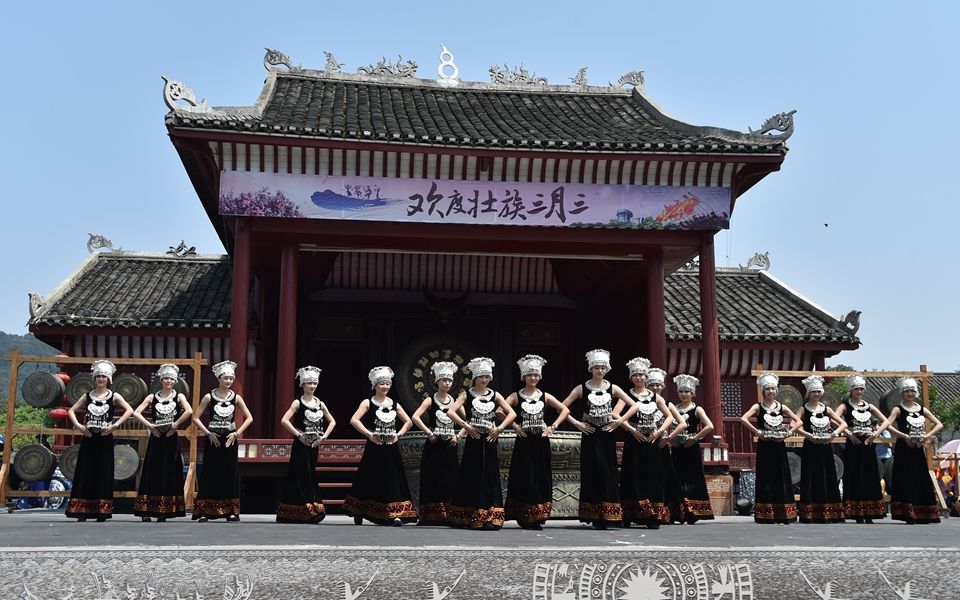| Zhuang Ethnic Minority |
| From:湖南省政府门户网 | Date Add in:2020-08-19 17:35:22 [A A] |
|
With a population of 23.56 thousand, the Zhuangs are distributed sparsely but widely throughout Hunan. Most of the Zhuangs live in Zhuang village of Gingtang in Yao autonomous county of Jianghua. The Zhuang ethnic minority has its own language which belongs to the Zhuang-Dai branch of Zhuang-Dong Austronesian, part of the Chinese-Tibetan Phylum. Ancient Zhuang characters appeared in the Southern Song Dynasty (1127-1279), but never became popularized. In 1955 the central government helped them create a writing system based on the Latin alphabet. Still the Chinese language is commonly used among the Zhuangs. Living Quarters Most Zhuangs now live in one-story houses the same as the Hans. But some have kept their traditional two-story structures with the upper story serving as the living quarters and the lower as stables and storerooms. The old housing style, they think, suits the mountainous terrain and the humid climate. Clothing Contemporary Zhuang clothing is similar to that of the Han people. But traditional dresses remain in many places or are worn for special occasions. For instance, some elderly women like collarless, embroidered and trimmed jackets buttoned to the left together with baggy trousers, embroidered belts and shoes and pleated skirts. Some women prefer collarless, left-buttoned jackets, square kerchiefs and loose trousers -- all in black. They fancy silver ornaments. Food The Zhuangs are mainly engaged in agriculture, with paddy and corn as their main crops. Rice and corn make up the Zhuangs' staple food. Customs Tattooing used to be an ancient Zhuang custom. A great writer of the Tang Dynasty (618-907), Liu Zongyuan, mentioned it in his writings. Chewing betel nuts is a habit still popular among some Zhuang women. The Zhuangs are polytheists, worshipping, among other things, giant rocks, old trees, high mountains, land, dragons, snakes, birds and ancestors. Taoism and Buddhism have also had a deep influence on the Zhuangs since the Tang Dynasty (618-907). Foreign Christian and Catholic missionaries came to the area in the 19th and early 20th centuries, but their influence was limited to the cities and towns. Folk Culture and Art Zhuang brocade, famous both at home and abroad, is a splendid handicraft which originated in the Tang Dynasty (618-907). Woven in beautiful designs with natural cotton warp and dyed velour weft, the brocade is excellent for making quilt covers, table-cloths, braces, aprons and handbags. Legends, fairy tales, stories and ballads frame the folk literature of the Zhuangs who are also famous for their singing. Sweet songs can be heard wherever you go in the Zhuang area. Extemporaneous melodies and lyrics and clever use of metaphors, riddles and banter add charm to their songs. Common Zhuang musical instruments include the Suona (Chinese cornet), bronze drum, cymbal, gong, Sheng (Chinese wind pipe), Xiao (vertical bamboo flute), Dizi (Chinese flute) and Huqin (a stringed instrument) made of horse bones. Zhuang dances are characterized by distinct themes, forceful and nimble steps, jocular and humorous gestures and true-to-life emotions. The Rice-Husking Dance, Silk-Ball Dance, Shrimp-Catching Dance, Tea-Picking Dance, Shoulder-Pole Dance and Bronze-Drum Dance not only vividly depict the Zhuangs' life and work, but also display their straightforward, unbending nature. Yet what combines the Zhuangs' folk literature, music, dance and other forms of art is Zhuang Opera which first originated from religious rites in the Tang Dynasty. Festivals While sharing many festivals with the Hans, such as the Spring Festival, the Mid-Autumn Festival, the Dragon Boat Festival, etc. the Zhuangs have three red-letter days of their own: the Devil Festival, the Cattle Soul Festival and the Feasting Festival. The Devil Festival, which falls on July 14 on the lunar calendar (usually in August on the Gregorian calendar), is an important occasion next only to the Spring Festival. On that day, every family prepares chicken, duck and five-colored glutinous rice to be offered as sacrifices to ancestors and ghosts.
|
Co-sponsored by Information Office of Hengyang Municipal People's Government Technical Support & Design:Hengyang Normal University
ICP NO:05002289
